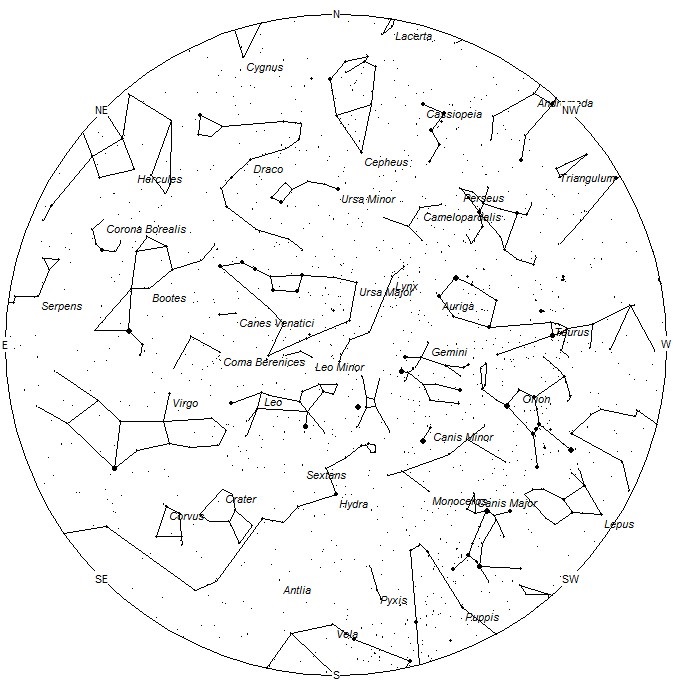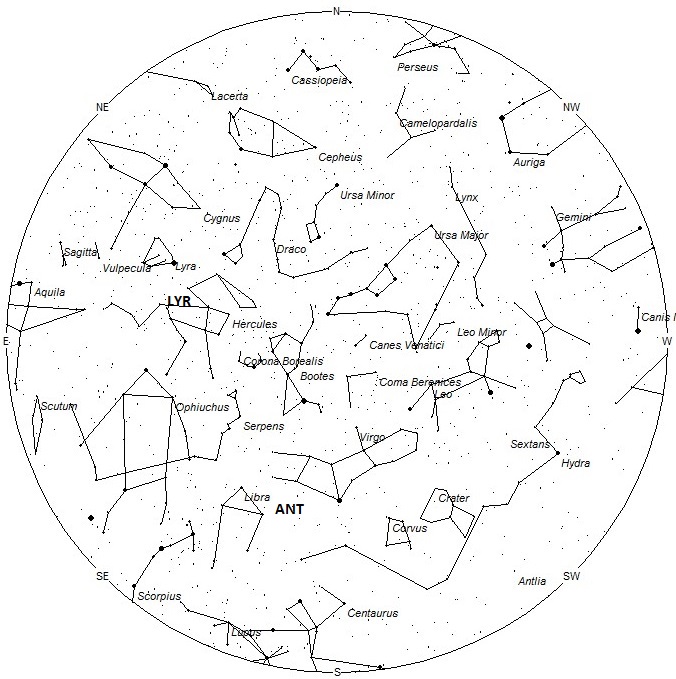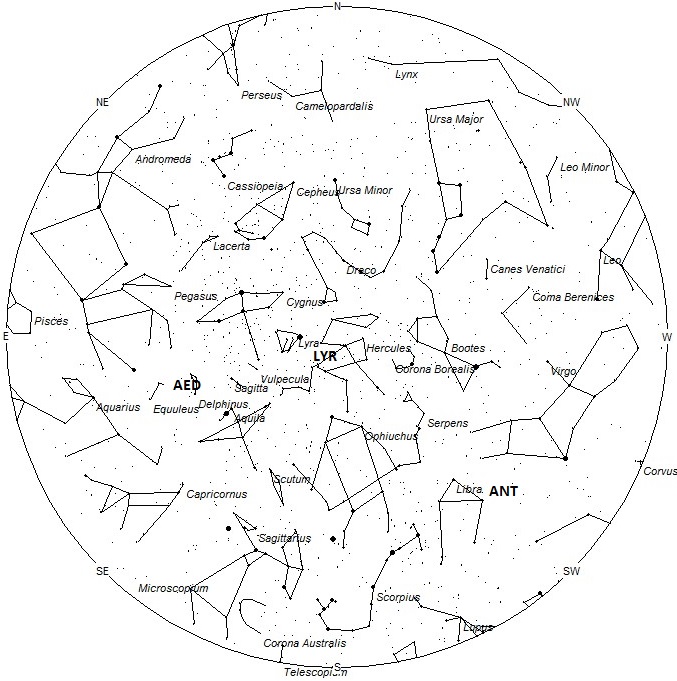During this period the moon will reach its full phase on Friday April 19th. This weekend the waxing gibbous moon will set during the early morning hours and will not interfere with meteor observing the remainder of the night. Next week though the window of dark skies shrinks with each passing night so by Wednesday the nearly full moon will remain above the horizon nearly all night. Hourly meteor rates for evening observers this week are near 2 as seen from mid-northern latitudes (45N) and 3 as seen from tropical southern locations (25S). For morning observers the estimated total hourly rates should be near 7 as seen from mid-northern latitudes and 10 from the southern tropics. The actual rates will also depend on factors such as personal light and motion perception, local weather conditions, alertness and experience in watching meteor activity. Rates are reduced during this period due to interfering moonlight. Note that the hourly rates listed below are estimates as viewed from dark sky sites away from urban light sources. Observers viewing from urban areas will see less activity as only the brighter meteors will be visible from such locations.
The radiant (the area of the sky where meteors appear to shoot from) positions and rates listed below are exact for Saturday night/Sunday morning April 13/14 . These positions do not change greatly day to day so the listed coordinates may be used during this entire period. Most star atlases (available at science stores and planetariums) will provide maps with grid lines of the celestial coordinates so that you may find out exactly where these positions are located in the sky. A planisphere or computer planetarium program is also useful in showing the sky at any time of night on any date of the year. Activity from each radiant is best seen when it is positioned highest in the sky, either due north or south along the meridian, depending on your latitude. It must be remembered that meteor activity is rarely seen at the radiant position. Rather they shoot outwards from the radiant so it is best to center your field of view so that the radiant lies near the edge and not the center. Viewing there will allow you to easily trace the path of each meteor back to the radiant (if it is a shower member) or in another direction if it is a sporadic. Meteor activity is not seen from radiants that are located far below the horizon. The positions below are listed in a west to east manner in order of right ascension (celestial longitude). The positions listed first are located further west therefore are accessible earlier in the night while those listed further down the list rise later in the night.
These sources of meteoric activity are expected to be active this week.
The pi Puppids (PPU) are active from April 17 through May 1. Maximum activity is expected on April 24 this year. The radiant is currently located at 07:00 (105) -44. This area of the sky is located in southern Puppis, directly between the 3rd magnitude stars known as sigma and nu Puppis. This area of the sky also lies 10 degrees northeast of the brilliant star known as Canopus (alpha Carinae). Activity from this source is best seen as soon as it becomes dark. Due to the southern location of this radiant, activity from the pi Puppids are best seen from the southern hemisphere where the radiant lies much higher in the evening sky. With an entry velocity of 15 km/sec., the average pi Puppid meteor would be of very slow velocity.
The center of the large Anthelion (ANT) radiant is currently located at 14:28 (217) -15. This position lies in western Libra, 5 degrees west of the 3rd magnitude star known as Zubenelgenubi (αlpha2 Librae). Due to the large size of this radiant, Anthelion activity may also appear from eastern Virgo as well as Libra. This radiant is best placed near 0200 Local Summer Time (LST), when it lies on the meridian and is located highest in the sky. Rates at this time should be near 2 per hour no matter your location. With an entry velocity of 30 km/sec., the average Anthelion meteor would be of slow velocity.
The first signs of Lyrid (LYR) activity may appear next week from a radiant located at 17:48 (267) +33. This area of the sky is actually located in eastern Hercules, 5 degrees north of the 4th magnitude star known as mu1 Herculis. Lyrid activity is best seen during the last dark hour before the start of morning twilight. Rates are expected to be low this week as maximum activity is not until April 23rd. With an entry velocity of 46 km/sec., the average meteor from this source would be of medium-swift velocity.
The April epsilon Delphinids (AED) were first identified by P. Jenniskens and R. Rudawska based on studying data from SonotaCo and CAMS observations. This source is currently listed among the “working ” showers of the International Astronomical Union but may be strong enough to be observed by visual means. The exact stream duration is not available but this source should be active for a least a week centered on the April 13th maximum. The radiant position at maximum is 20:42 (310) +13. This area of the sky is located in central Delphinus, 1 degree southeast of the 4th magnitude star known as Rotanev (beta Delphini). This radiant is best placed during the last hour before dawn when it lies highest above the horizon in a dark sky. Rates at this time should be near 1 per hour no matter your location. With an entry velocity of 41 km/sec., the average meteor from this source would be of medium velocity.
As seen from the mid-northern hemisphere (45N) one would expect to see approximately 5 sporadic meteors per hour during the last hour before dawn as seen from rural observing sites. Evening rates would be near 1 per hour. As seen from the tropical southern latitudes (25S), morning rates would be near 8 per hour as seen from rural observing sites and 2 per hour during the evening hours. Rates are reduced during this period due to moonlight.
The list below offers the information from above in a condensed form. Rates and positions are exact for Saturday night/Sunday morning except where noted in the shower descriptions.
| SHOWER | DATE OF MAXIMUM ACTIVITY | CELESTIAL POSITION | ENTRY VELOCITY | CULMINATION | HOURLY RATE | CLASS |
| RA (RA in Deg.) DEC | Km/Sec | Local Daylight Saving Time | North-South | |||
| pi Puppids (PUP) | Apr 24 | 07:00 (105) -44 | 15 | 18:00 | <1 -<1 | III |
| Anthelion (ANT) | – | 14:00 (210) -13 | 30 | 02:00 | 2 – 2 | II |
| Lyrids (LYR) | Apr 23 | 17:48 (267) +33 | 46 | 06:00 | <1 -<1 | I |
| April epsilon Delphinids (AED) | Apr 13 | 20:42 (310) +13 | 41 | 10:00 | <1 -<1 | IV |




